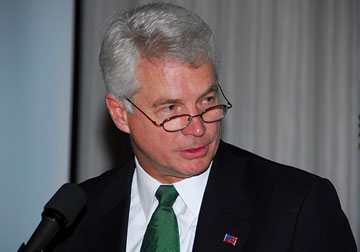
Environmentalists pushing for a U.S. 60 mpg (3.9 L/100 km) fuel-economy standard by 2025 say history shows auto makers benefit from strict regulation and such a lofty goal would not jeopardize the Detroit Three’s profits or market share.
“A higher fuel-economy standard is actually a way to protect auto company profits and jobs,” says Roland Hwang, director-transportation program at the Natural Resources Defense Council.
“Higher fuel-economy standards become the way that the auto industry can insulate or protect itself against (fuel) price volatility, protect its profits, protect its jobs and market share,” Hwang says during a teleconference with journalists Thursday to discuss a new poll finding Americans in favor of a 60-mpg corporate average fuel-economy standard.
Hwang points to the sudden run-up in gasoline prices two years ago, when the U.S. average eclipsed $4-per-gallon. Auto makers such as the former General Motors Corp. and Chrysler LLC were caught with truck-heavy lineups as consumers fled to smaller, more fuel-efficient vehicles.
The lopsided portfolios at GM and Chrysler led to a sales slide and, combined with a record recession, contributed to their bankruptcies. Today, General Motors Co., Chrysler Group LLC and Ford Motor Co. are racing to revamp their lineups with more efficient cars and cross/utility vehicles, as well as new fuel-sipping technologies.
A similar scenario occurred in the 1970s, which prompted the formation of CAFE, Hwang says.
“So a higher fuel-economy standard is the best insurance (for) the auto industry,” he adds. “General Motors, of all companies, is now revamping their lineup and preparing for that $4-a-gallon inevitable future for gasoline.”
Last week, the Union of Concerned of Scientists, NRDC, Sierra Club and Environment America appealed to the National Highway Traffic Safety Admin. and the Environmental Protection Agency to set a fleet-wide fuel-economy standard of 60 mpg by 2025.

Later this month, the two government agencies will release a Notice of Intent to Issue a Proposed Rule for 2017-2025 light-vehicle fuel-economy and tailpipe emissions standards, as mandated in May by President Obama. A final decision is expected within the next 12 months.
The environmental groups sense a political will exists to pursue such a high standard, given the historic agreement they and lawmakers reached with the industry for new rules taking effect with the ’12 model year.
But the industry balked at last week’s 60-mpg-plea, suggesting it might be too early to talk about such a high standard when the newest rule, which ultimately calls for 34.4 mpg (6.8 L/100 km) by 2016, hasn’t even taken effect.
“Just last year, auto makers supported reaching 35 mpg-plus by 2016, and before we have even achieved those new heights, the calls have begun to almost double mileage,” says Dave McCurdy, president and CEO of the Alliance of Automobile Manufacturers, a Washington lobbyist for the industry.
“Clearly, we live in a period of extreme political volatility, and some groups are promoting their political wish-list prior to the elections,” he says in a statement.
“Instead of plucking numbers out of the air, we should base policy on science and expert reviews of all the factors, like affordability of technology, availability of low-carbon fuels and the state of the electric infrastructure,”
Ann Mesnikoff, director of the Sierra Club’s Green Transportation Campaign, says auto makers need such direction.
“One of the issues we see with setting fuel-economy standards is the longer-term horizon the auto industry has to meet, the higher we can go,” she says. “They need that direction. We’ve had decades of stagnation and that resulted in increased oil dependence and increased carbon-dioxide emissions.”
The debate over lofty fuel-economy targets ignites again this week with a new poll commissioned by the environmental groups showing Americans overwhelming favor high fuel-economy standards for auto makers and a 60-mpg target.
The Mellman Group polled 1,000 voters and found 74% want the government to set high standards, with 66% saying they would still support the push even if it added $3,000 to the cost of a vehicle.
According to the polster, 86% think the technology already exists to hit a fleet-wide average of 60 mpg, or could be developed with a serious effort.
A large majority also believes it “very likely” or “somewhat likely” 60 mpg would reduce their fuel bills, decrease air pollution, make the U.S. less dependent on Middle East oil and protect auto industry jobs, the poll finds.
Mellman says the support crosses political lines and household incomes, as well as homes relying on incomes from the auto and agricultural industries.




